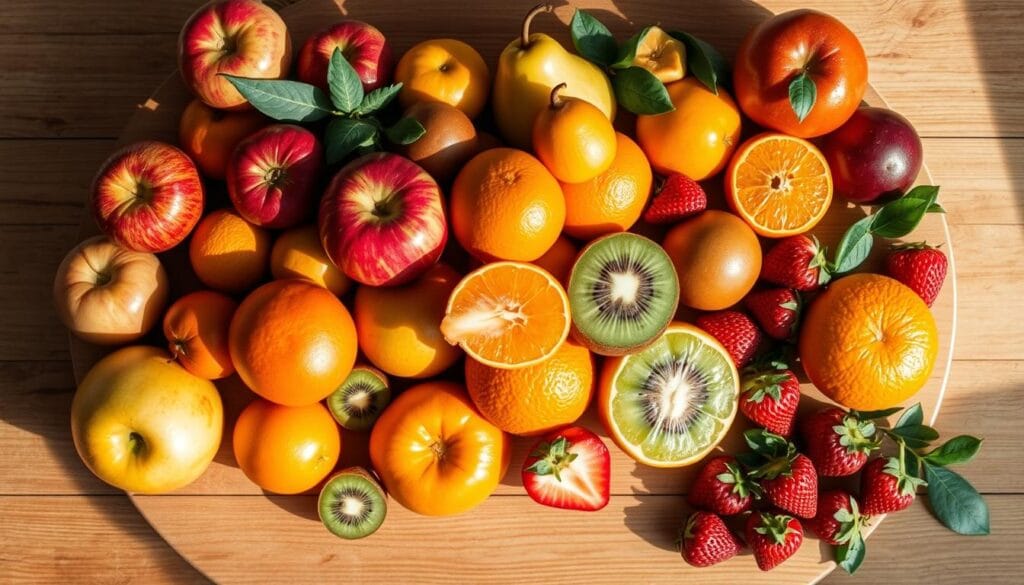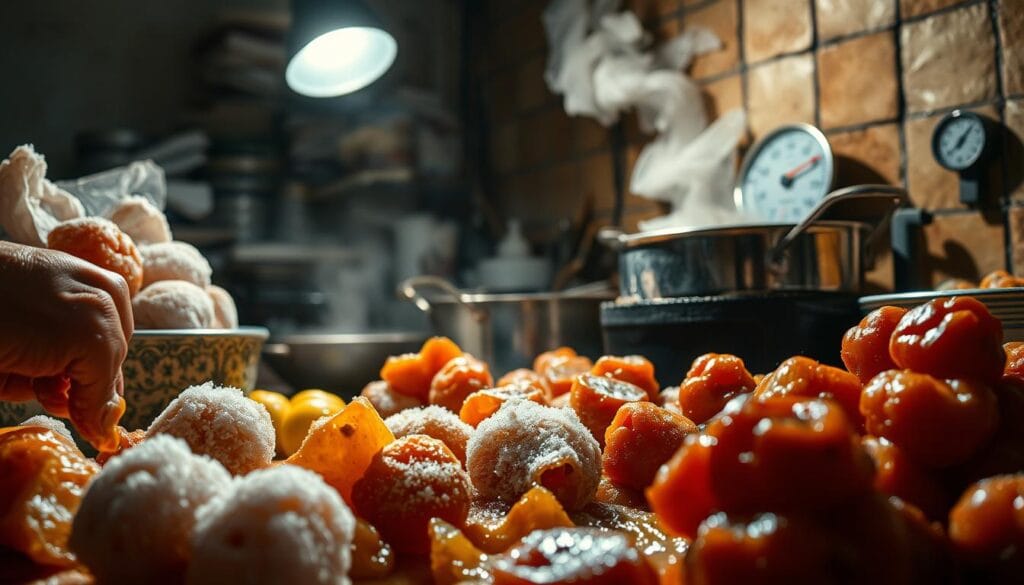Imagine biting into a sweet, crispy shell that crackles with each crunch, revealing the juicy fruit hidden within—this is the magic of tanghulu. A traditional Chinese snack, tanghulu embodies not just a flavor but a cherished memory, often enjoyed during festive gatherings. The enchanting allure of sugar-coated fruit captures the heart and transforms a simple moment into a celebration.
In today’s fast-paced world, bringing this delightful treat into your own kitchen connects you with a rich culinary history while creating new memories with loved ones. As you embark on this journey to craft homemade tanghulu, you’ll discover that you’re not just making a dessert, but sharing joy, warmth, and a slice of your culture.
Key Takeaways
- Tanghulu is a delightful traditional Chinese snack featuring sugar-coated fruit.
- Homemade tanghulu allows you to customize your fruit selections and flavors.
- Understanding the history adds depth and appreciation for this festive favorite.
- Choosing the right fruits is essential for achieving the best results.
- Mastering sugar syrup techniques is key to creating the perfect crunchy coating.
Introduction to Tanghulu: A Delightful Chinese Snack
Tanghulu is a favorite Chinese street food. It’s known for its crunchy sugar coating and juicy fruit. This popular dessert is often made with candied hawthorn but also includes fruits like strawberries and grapes.
Each bite is a mix of sweet and sour. It’s a great way to try the flavors of Chinese cuisine. It’s a treat that’s both exciting and satisfying.
In markets and festivals, tanghulu is a big hit. Making it at home is easy and fun. It’s a chance to enjoy a piece of Chinese street food in your own kitchen.
History and Origins of Tanghulu
The tanghulu history goes back to the Song Dynasty (960-1279) in China. It started as a folk remedy for health issues. A legend says it was made to cure the emperor’s favorite concubine with a sugar-coated hawthorn berry.
Over time, tanghulu became more than a remedy. It turned into a tasty treat for special occasions. It’s a big part of Lunar New Year celebrations, symbolizing good fortune and happiness.
Today, tanghulu is loved not just in China but also in South Korea and Japan. These countries have made their own versions of this sweet treat. This mix of cultures makes tanghulu a favorite snack in Asia.
Essential Ingredients for Homemade Tanghulu
To make a tasty tanghulu, you need to know the key ingredients. This sweet treat has three main parts: fresh fruit, white sugar, and water. The fruit you pick will change the taste and look of your tanghulu. Choose 1 pound of your favorite fruits like strawberries, grapes, or tangerine slices.
White sugar is the base of the syrup, giving it a crunchy feel when it cools down. You’ll need about 3 cups of sugar for a thick, sweet layer. Also, 1.5 cups of water are needed to make the syrup. This mix turns your fruits into a tasty treat, keeping their flavor and texture.
Here’s a quick overview of the tanghulu recipe ingredients:
| Ingredient | Quantity |
|---|---|
| Fresh Fruit | 1 pound (e.g., strawberries, grapes, tangerine slices) |
| Granulated White Sugar | 3 cups |
| Water | 1.5 cups |
Choosing the Right Fruits for Your Tanghulu Recipe
Choosing the right fruits is key for a great tanghulu snack. Hawthorn berries are classic, but other fruits work well too. Strawberries, grapes, and mandarin slices add vibrant flavors and textures.
Look for firm, ripe fruits for the best tanghulu. Firm fruits stick well to the candy coating. Ripe fruits taste better. For example, strawberries should be bright red and juicy, and grapes should be solid and plump.
Whether you like soft fruits like strawberries or crunchy ones like apples, your choice matters. The right mix creates a snack that’s both tasty and satisfying.

Preparing Your Fruit Skewers
To make perfect tanghulu, start with preparing the skewers. This step is key for both looks and taste. Make sure your fruit is clean and dry. This helps the sugar stick better when you dip the skewers.
Washing and Drying the Fruit
First, wash the fruit under cold water. This removes dirt and pesticides. Then, dry it well with a cloth or paper towel.
Removing moisture is important. It keeps the sugar syrup from falling off. This gives your tanghulu a shiny, sticky finish.
Skewering Methods
After drying, it’s time to skewer the fruit. Use wooden skewers and add one to three pieces per skewer. This makes dipping easier.
Choose skewers that fit the fruit’s size and weight. Thicker skewers work best for bigger fruits like strawberries. Smaller fruits like blueberries need thinner skewers. Good skewers hold the fruit well and look great.
Making the Perfect Sugar Syrup for Tanghulu
Creating the perfect sugar syrup is key for great tanghulu. You need to focus on cooking sugar techniques. Start by measuring sugar and water accurately. The right mix is important.
Don’t stir the mixture once it’s in the pot. Let the sugar dissolve naturally as it heats up.
Understanding Sugar Cooking Techniques
Using the right cooking techniques is important for a clear syrup. When making sugar syrup for tanghulu, watch the mixture closely. Stirring can add unwanted crystals, ruining the texture.
As the syrup heats, keep an eye on it. Aim for a hard ball stage at 300°F for the perfect crunch.
Temperature and Timing for Ideal Syrup Consistency
Timing is key for the syrup’s texture. Use a candy thermometer for accurate syrup temperature. Remove it from heat at 300°F.
Let it cool a bit to avoid splatters. This way, you get a glossy, hard outer layer on your tanghulu. It will be crunchy and delicious.

Step-by-Step Guide: Creating Your Tanghulu
Making tanghulu is a fun process that mixes the sweetness of fruit with the crunch of sugar syrup. This guide will show you how to make tanghulu. You’ll learn how to dunk the fruit into hot syrup and cool it down. This will make your homemade tanghulu a hit.
Dunking the Skewers into Hot Syrup
First, prepare your fruit skewers. Then, heat the syrup to 300°F (hard crack stage). Hold each skewer by the stick, keeping your hands away from the fruit. Dip the skewers into the syrup, rotating them for an even coat. This step is key for a shiny finish.
Cooling Techniques for Tanghulu
After dipping, cool the skewers quickly. Put them in an ice water bath. This method sets the sugar fast, creating a hard shell. As it cools, the syrup will stick to the fruit, covering it in sweetness.
Let the skewers sit in the ice bath for 30 seconds. Then, place them upright on a cooling rack to dry completely.
Common Mistakes to Avoid When Making Tanghulu
Making tanghulu can be fun, but some mistakes can ruin it. One big error is not drying the fruit enough before syrup. If the fruit is wet, the sugar won’t stick well, making it soft.
Another mistake is stirring the sugar mixture while it cooks. Stirring can make the sugar form crystals, making the syrup cloudy. It’s important to keep the temperature steady for a shiny finish.
It’s key to watch the syrup’s temperature closely. If it’s too cold, it won’t set right. If it’s too hot, it becomes too hard. Knowing these details will help you make better tanghulu.

Tips and Tricks for Perfecting Your Tanghulu Technique
Making tanghulu at home can be very rewarding. You need the right tools and knowledge. The best equipment and safe sugar handling make the process smoother. Here are some tips to help you make better tanghulu.
Best Equipment for Making Tanghulu
Choosing the right equipment is key to making delicious tanghulu. Here are the essentials:
- Stainless-steel pot: It heats sugar syrup evenly.
- Sauté pan: It has a wide surface for easy fruit skewer dipping.
- Heat-resistant spatula: It helps stir and prevents syrup from sticking.
- Thermometer: It ensures the syrup is at the right temperature.
- Baking sheet: Lined with parchment paper for cooling tanghulu.
Handling Hot Sugar Safely
Handling hot sugar safely is very important. Molten sugar can burn you badly. Remember these tips:
- Wear protective clothes like long sleeves and heat-resistant gloves.
- Have a bowl of cold water ready to cool burns quickly.
- Stay focused when working with hot sugar to avoid accidents.
- Never leave the stove alone while making the syrup.
Conclusion
Making tanghulu at home turns your kitchen into a fun place. It honors traditional Chinese culture. By following this guide, you’re not just making a sweet treat. You’re also keeping alive a tradition loved for generations.
Getting started is easy and fun. You’ll pick the right fruits and make the sugar syrup. Each step makes your tanghulu more authentic. The crispy shell and fresh fruit make every bite special.
Making tanghulu is more than just cooking. It’s about making memories and enjoying perfect bites. So, get ready to have fun and make every batch a delicious celebration.


1 thought on “How to MakeTanghulu at Home in 2025”
Comments are closed.